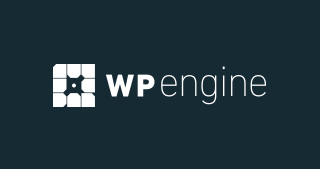Email marketing is one of the most powerful tools available to businesses today, offering an effective way to engage customers, generate leads, and increase conversions.
Among the many email marketing platforms available, Moosend and Mailchimp are two of the most popular options.
Both platforms offer a range of features designed to help businesses succeed in their email marketing efforts, but they cater to different needs, preferences, and budgets.
In this post, we will dive into a detailed comparison of Moosend vs. Mailchimp, covering their key features, pricing, pros and cons, and frequently asked questions (FAQs).
Whether you’re a small business owner, marketer, or large enterprise, this comparison will help you decide which platform is best suited for your business.
When it comes to email marketing, businesses need a platform that not only makes it easy to create and send emails but also offers automation, analytics, and personalization options.
Moosend and Mailchimp are two well-established platforms that meet these requirements, but each offers unique features and pricing structures.
Moosend is known for its simple user interface, affordable pricing, and robust automation features, making it a go-to solution for startups and small businesses.
On the other hand, Mailchimp is a widely recognized name in the industry, offering a comprehensive range of features for businesses of all sizes, though at a higher price point.
Let’s explore both platforms in detail to help you make an informed choice.
Overview of Moosend and Mailchimp
Overview of Moosend
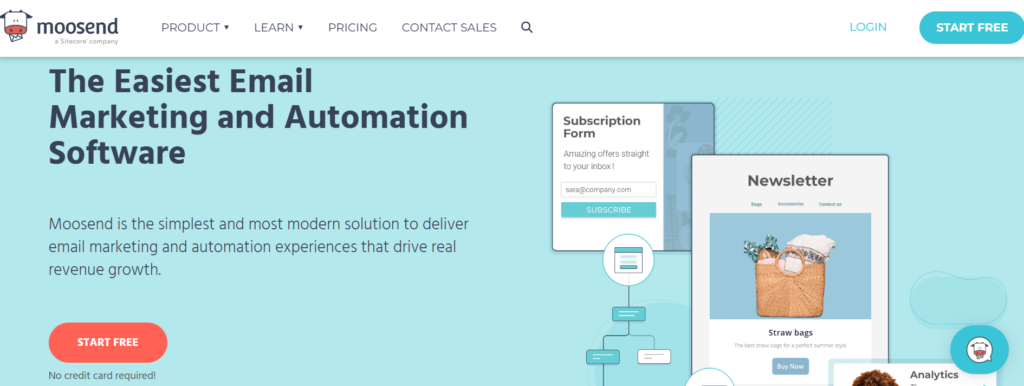
Moosend is an all-in-one email marketing platform designed to simplify the email marketing process for businesses. Founded in 2011, Moosend quickly gained popularity due to its easy-to-use interface, powerful automation tools, and cost-effective pricing.
It offers features like a drag-and-drop email editor, automation workflows, and e-commerce integrations that allow users to set up sophisticated campaigns without needing extensive technical expertise.
Moosend also provides excellent analytics and reporting capabilities, giving businesses real-time insights into how their campaigns are performing.
With a free plan that includes essential features, Moosend is especially appealing to small and medium-sized businesses looking to scale their email marketing efforts affordably.
Overview of Mailchimp
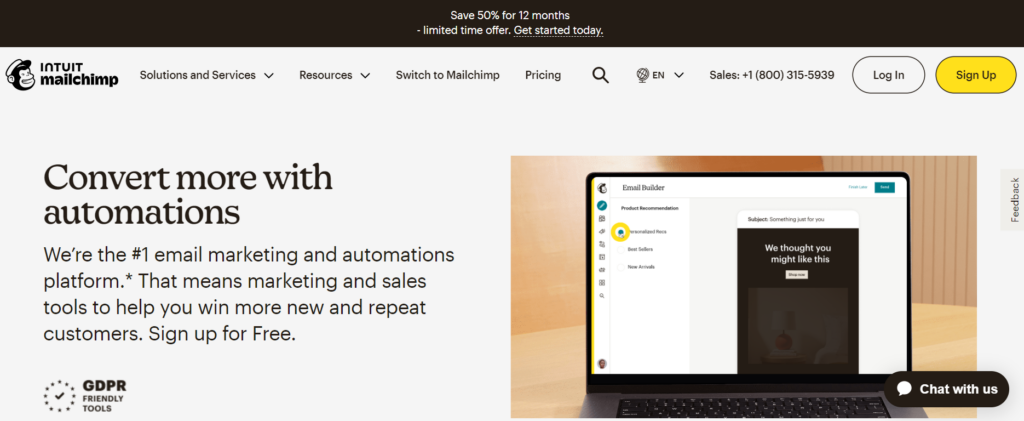
Mailchimp has been a dominant player in the email marketing industry for over two decades. Founded in 2001, Mailchimp offers a wide range of tools for businesses, from email marketing to marketing automation, landing pages, and even website building.
Mailchimp is well-known for its advanced features and integrations, as well as its user-friendly interface that appeals to marketers and non-technical users alike.
Mailchimp’s focus extends beyond email marketing to include CRM functionalities, making it an attractive option for businesses seeking a comprehensive marketing solution.
However, Mailchimp’s pricing is on the higher side compared to Moosend, which may be a consideration for businesses with smaller budgets.
Features Comparison: Moosend vs. Mailchimp
1. Email Editor
Moosend:

Moosend provides an intuitive drag-and-drop email editor that allows users to create professional-looking emails without any coding knowledge.
The editor comes with a variety of pre-built templates and customization options, making it easy to design emails that match your brand.
Moosend also includes a template library with industry-specific designs, allowing users to save time by customizing these ready-made templates.
Mailchimp:

Mailchimp also offers a drag-and-drop email editor, but it is more advanced and feature-rich compared to Moosend’s editor.
Mailchimp includes a larger variety of design elements and greater flexibility in customizing email layouts. Users can also create multi-column designs and access more detailed styling options for fonts, colors, and buttons.
2. Automation
Moosend:
One of Moosend’s standout features is its powerful marketing automation tools. Moosend enables users to set up automation workflows based on various triggers, such as customer behavior, purchase history, or email interactions.
The automation builder is visual and easy to use, allowing you to create workflows for tasks like abandoned cart emails, welcome series, and product recommendations.
Mailchimp:
Mailchimp’s automation capabilities are also quite robust. It offers pre-built automation workflows and the ability to set up advanced sequences based on customer interactions.
Mailchimp integrates with a wider range of third-party apps, allowing for more complex automation setups. However, Mailchimp’s automation features are more advanced in higher-tier plans, whereas Moosend offers its automation tools across all pricing tiers.
3. Segmentation and Targeting
Moosend:
Moosend offers excellent list segmentation options, allowing users to divide their email lists based on different criteria like demographics, customer behavior, or purchase history.
This ensures that users can send highly targeted and personalized emails to specific segments, leading to better engagement.
Mailchimp:
Mailchimp is known for its advanced segmentation and targeting features. It allows users to create complex segmentation rules based on customer data, engagement levels, and even predictive insights.
Mailchimp’s advanced segmentation features are a major plus for larger businesses that require precise targeting.
4. Integrations
Moosend:
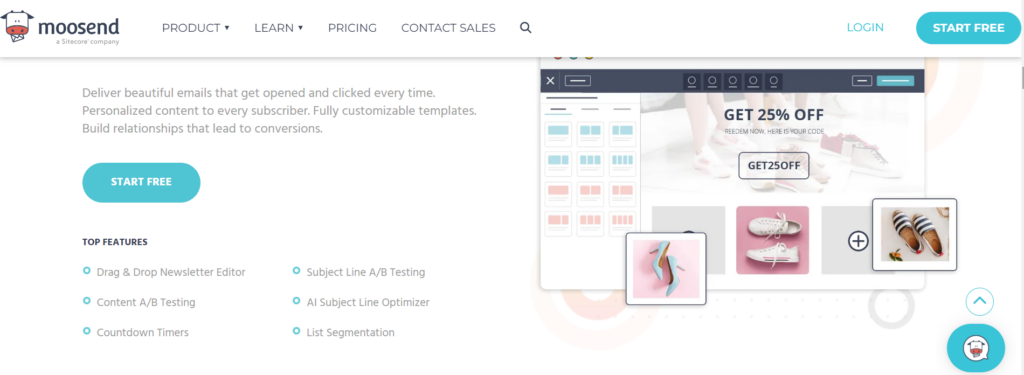
Moosend integrates with popular platforms like Shopify, WooCommerce, and WordPress. Its integrations are primarily focused on e-commerce and website platforms, making it a solid choice for online retailers.
However, Moosend does not offer as many integrations as Mailchimp, particularly when it comes to third-party apps.
Mailchimp:
Mailchimp has an extensive list of integrations, including CRM tools, e-commerce platforms, social media channels, and more.
It integrates seamlessly with platforms like Salesforce, Shopify, QuickBooks, and even Google Analytics. This makes Mailchimp a versatile tool for businesses that use multiple apps and need them to work together seamlessly.
5. Analytics and Reporting
Moosend:
Moosend provides real-time analytics and reporting, allowing users to track key metrics such as open rates, click-through rates, conversions, and bounce rates.
The platform also includes visual reports that help users understand the performance of their campaigns at a glance.
Mailchimp:
Mailchimp offers detailed analytics and reporting features as well. It provides advanced reporting options like customer lifetime value, purchase likelihood, and engagement tracking.
Mailchimp’s reports are more comprehensive than Moosend’s, making it a better option for businesses that require in-depth data analysis.
Pricing Comparison of Moosend and Mailchimp :- A Detailed Pricing Comparison for Every Budget
Pricing is a critical factor when choosing an email marketing platform. Here’s how Moosend and Mailchimp compare in terms of cost:
Moosend Pricing:

- Free Plan: Moosend’s free plan allows you to send unlimited emails to up to 1,000 subscribers. This plan includes essential features like automation workflows, email templates, and real-time analytics.
- Pro Plan: Starts at $9 per month and scales based on the number of subscribers. This plan includes landing pages, transactional emails, and phone support.
- Enterprise Plan: Custom pricing is available for larger businesses requiring advanced features such as a dedicated account manager, custom reporting, and premium support.
Mailchimp Pricing:
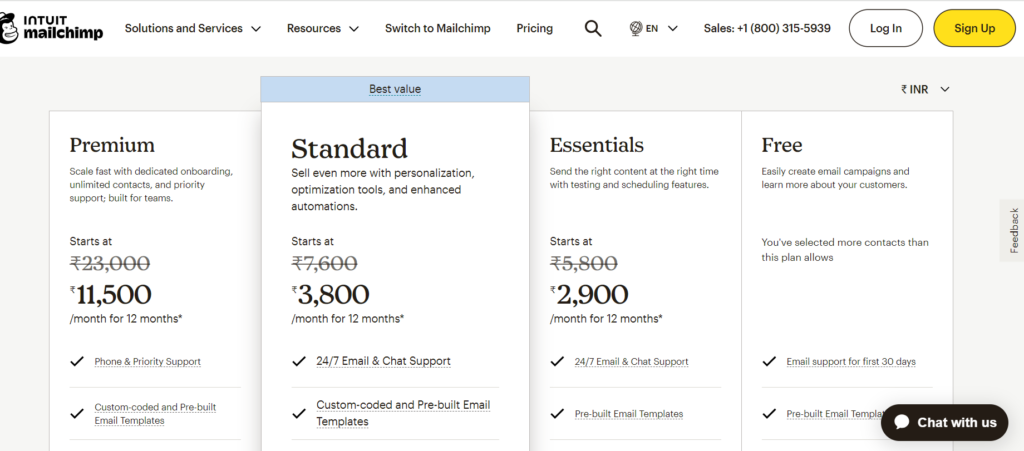
- Free Plan: Mailchimp’s free plan allows you to send up to 10,000 emails per month to 2,000 subscribers. However, this plan comes with limited features, and certain advanced tools like A/B testing and automation are restricted.
- Essentials Plan: Starts at $13 per month and includes additional features like A/B testing, more detailed analytics, and multi-step automation.
- Standard Plan: Starts at $20 per month and offers advanced segmentation, customer journey automation, and retargeting ads.
- Premium Plan: Starts at $350 per month for up to 10,000 contacts and includes all advanced features, such as predictive analytics, advanced segmentation, and priority support.
FAQ
1. Which platform offers better automation features?
Both Moosend and Mailchimp offer excellent automation features, but Moosend provides automation across all pricing tiers, while Mailchimp reserves advanced automation for higher-tier plans.
2. Does Moosend offer a free plan?
Yes, Moosend offers a free plan that allows users to send unlimited emails to up to 1,000 subscribers.
3. Can I use Mailchimp for free?
Yes, Mailchimp offers a free plan, but it has limited features compared to its paid plans.
4. Which platform is better for beginners?
Moosend is easier to use for beginners due to its simpler interface and straightforward pricing.
5. Can I integrate Moosend with Shopify?
Yes, Moosend integrates with Shopify, WooCommerce, and other e-commerce platforms.
6. Does Mailchimp offer CRM features?
Yes, Mailchimp includes basic CRM features, making it a more comprehensive marketing platform.
7. Is Moosend GDPR compliant?
Yes, Moosend is fully GDPR compliant, ensuring that your email marketing follows legal guidelines.
8. Does Mailchimp support advanced segmentation?
Yes, Mailchimp offers advanced segmentation features, especially in its higher-tier plans.
9. Which platform is more cost-effective?
Moosend is generally more affordable, especially for small businesses, while Mailchimp’s pricing can be more expensive, particularly for higher-tier plans.
10. Can I switch between plans in Moosend?
Yes, Moosend allows users to upgrade or downgrade their plans based on their business needs.
Conclusion
When comparing Moosend vs. Mailchimp, the right choice depends on your business’s specific needs and budget. Moosend shines in its affordability, ease of use, and powerful automation tools that are accessible.
in its free plan. This makes it an ideal choice for small businesses and startups that want to get the most value for their money.
Its straightforward pricing model, coupled with essential features like real-time analytics, A/B testing, and excellent e-commerce integrations, makes it a cost-effective and highly functional solution.


